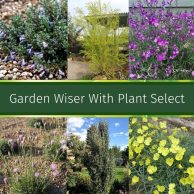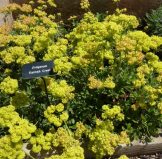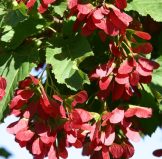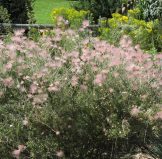
By Mikl Brawner
Not Just Another Pretty Face
We gardeners see a lot of branded plants in branded pots pushed with a lot of money to make a lot of money. That’s not the story with Colorado’s Plant Select program. Plant Select began as, and continues to be a plant promotion program genuinely aimed at the success of Rocky Mt. gardeners. It’s goals include saving water, supporting pollinators and encouraging a western garden aesthetic.
I’ve been in the nursery business for 31 years and one of the most frustrating problems I keep seeing is when a wholesale nursery “discovers” a great new plant and grows it for sale, and then it disappears in two years because not enough people bought it. Why not? Because most wholesale nurseries don’t have a system to promote that special plant.

Eriogonum ‘Kannah Creek’
Back in the mid ‘80s this problem, as well as the very limited selection of perennials for the west, inspired a few dedicated, passionate and visionary plants people to brainstorm a solution. Jim Klett, Panayoti Kelaidis, Gayle Weinstein and Al Gerace were in the avant-garde. Jim Klett is a professor at CSU, but beyond teaching he has a passion for testing woody plants that he has sourced from all over the country. Panayoti Kelaidis, currently the Director of Outreach at Denver Botanic Gardens, is a passionate plant explorer, seed collector and plant proselytizer. Gayle Weinstein, who was a Denver landscape designer and consultant, may be credited with coming up with the idea of a plant promotion program, and Al Gerace, formerly CEO of Welby Gardens helped figure out how the program could pay for itself and therefore survive into the future. (of course I’m simplifying and probably leaving some people out)
Jim Klett chaired meetings, provided leadership and organizational structure and woody plant research. Panayoti Kelaidis tested and displayed new plants at DBG, shared plants and seed with gardeners and growers, and came up with sexy and sustainable western perennials that caught public attention. Al Gerace suggested plant tags/royalties to provide income and encouraged demonstration gardens to inspire gardeners and encourage purchases.
This unique partnership of university, botanic garden and the green industry is working remarkably well. Jim Klett said, “Our program has been much more successful, in my opinion, because of the three-way approach.” Other, mostly profit-motivated programs, are ready to promote a plant just because it is new or unusual. Plant Select, originated and driven by sincere civil servants and passionate plant professionals, is on a mission to present and encourage the cultivation of water-wise, tough, durable, beautiful, successful, climate-resilient plants. In Colorado, we must garden for certain cultural conditions that can be the death of eastern plants. Our alkaline soils, dry conditions, sunny winters, volatile mountain weather plus strong winds and hail, mean require specially adapted plants.

Acer tataricum, ‘Hot Wings’ Maple
Over the 26 years since its first plant introduction in 1997, Plant Select has showcased 172 different plants, including many Colorado native plants. This progress has been enriched by the insights and plant introductions of local plant professionals. Scott Skogerboe, head propagator at Ft. Collins Wholesale Nursery, saved some great shrubs abandoned at the Cheyenne Horticultural Station by propagating them and bringing them to the attention of Plant Select. Lauren Springer, landscape designer, author and eagle-eyed plantswoman, has brought Plant Select a number of tough beauties. Kelly Grummons, long-time nurseryman, propagator and plant-lover, has allowed a number of his plant finds and breeding selections to enter into the Plant Select program. And the late David Salman bred, found, photographed, described and promoted great western plants some of which came to Plant Select. Credit should also be given to the wholesale nurseries who propagate and produce these “new” plants, who are at risk if they don’t sell.
Just in the last five years, Plant Select has “sold” (collected propagation fees on) eleven and half Million plants. This not only represents success for the program, it also represents a significant influence on our ecosystems since gardeners are growing these plants, better adapted to western conditions, saving water, increasing populations of native plants and supporting pollinators.
Plant Select’s boot-strap financing system (expanding slowly through its own profits) paid for its first director, Pat Hayward, in 2008 and since 2017, its current director, Ross Shrigley. With the direction of at least two committees, a plant evaluation program and plenty of opinions, Ross is leading Plant Select forward. He is continuing with a strong focus on drought tolerance (water conservation), disease resistance, climate-resilience, dry-shade tolerance, and expanding the program to include other western states. His passion for good plants and service to the community continues to improve this already excellent program.
Has Plant Select promoted some duds? Are some selections short-lived? Are some not water-wise? Has the program made mistakes like getting people excited about a plant before the industry could produce it? Of course. But let’s celebrate some examples of the program’s remarkable success.

Fallugia paradoxa -Apache Plume
Plant Select’s focus on drought tolerance is naturally intelligent and timely. This year the precipitation total for Boulder through June is 9.65”, in 2019 it was 13.02”, in 2020 it was 12.64” and in 2021 it was 15.62” through June. Weather predictions indicate warmer and drier conditions for the west. If we are forced under watering restrictions, like in 2002, lawns and gardens dependent on moderate watering will, of course, suffer and plants will die.
These Plant Select plants are ones I would consider to be very resilient to dry and hot conditions:
Hot Wings Maple-Acer tataricum
Chieftain Manzanita-Arctostapholos Chieftain
Kannah Creek Sulfur Flower-Eriogonum umbellatum ‘Kannah Creek’
Woodward Juniper
Penstemon mensarum
Penstemon rostriflorus
Philadelphus lewisii ‘Cheyenne’
Viburnam ‘Mini Man’
Chocolate Flower-Berlandiera
Fernbush-Chamaebatiaria millefolium
Redbead Cotoneaster-Cotoneaster racemiflorus soongorica
Silverheals Horehound-Marrubium rotundifolia
Dwarf Mt. Lover-Paxistima canbyi
Dwarf Leadplant-Amorph nana
Baby Blue Rabbitbrush-Ericameria n. v.nauseosus
Giant Sacaton-Sporobolus wrightii
Snow Mesa Buckwheat-Eriogonum wrightii wrightii
Mojave Sage-Salvia pachyphylla
Autumn Amber Sumac-Rhus trilobata ‘Autumn Amber’
Apache Plume-Fallugia paradoxa
Russian Hawthorn-Crataegus ambigua
And there are more, and I have very strict standards for drought tolerance, based on my own experience. Promoting these plants is a great service to our gardening community. Many of them are natives supporting native pollinators and many, I believe we will find, will turn out to be good Firescaping plants.
Drought tolerance is just one area demonstrating the high performance of the Plant Select program. Go to PlantSelect.org to see the great colorful perennials that the program has promoted.
For the dedication, passion and perseverance of the people behind the Plant Select program, we owe our appreciation and gratitude. We need this kind of ecological integrity now more than ever.
